Hanok stays offer accommodation in a traditional Korean house. The trend is growing ever popular among the young, as well as older generations feeling nostalgic for the houses of their childhood. Gurume Resort in Andong, North Gyeongsang Province is one such destination providing rooms in hanok. In the sprawling resort, old Korean houses are an actual place to live and enjoy, rather than just cultural assets.
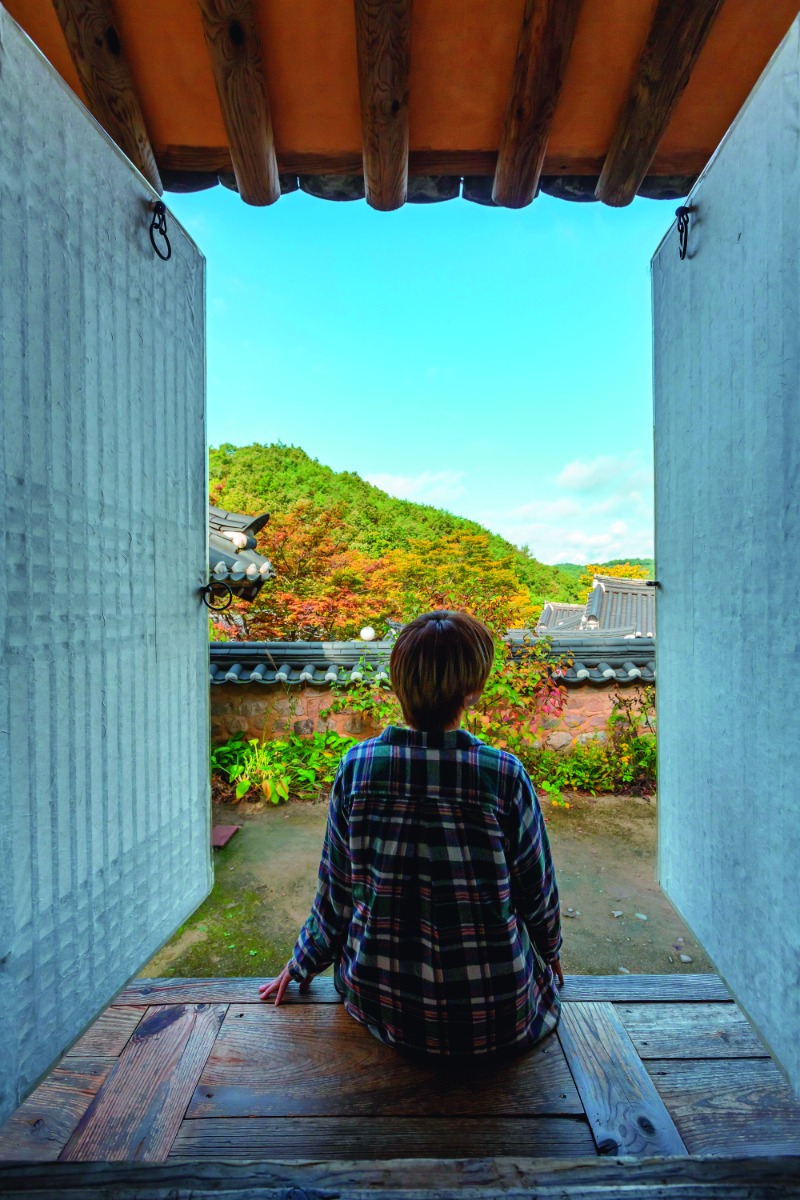
From the narrow veranda of Seounjeong Pavilion, one of the seven old houses in Gurume Resort in Andong, one can enjoy distant views beyond the low stone wall. The house was originally built in the 1840s by Yi Eon-sun, a civil official and ninth generation descendant of Yi Hwang, an eminent Confucian scholar of the mid-Joseon era. It was relocated to the present site in 2008.
Last autumn, I had the chance to spend a night in an old hanok. It wasn’t long after Chuseok, the autumn harvest festival, and the sky was getting clearer and bluer as the season progressed. The scheduled day came quickly as I pictured myself sitting on the wooden floor of an old house, enjoying the autumn mood.
From the moment I started planning the trip, I rummaged through childhood memories of my maternal grandparents’ house, where I had lived for a while. As I recalled it, it was neither an impressive tiled-roof house nor a simple thatched cottage. I asked about the house when I called my uncle, who told me that although the roof was thatched rather than tiled, the pillars, crossbeams and other structural components were the same as those used in Buddhist temples. Vague memories confirmed, scenes from the past came back to me in more detail.
The wood floor was worn so smooth and shiny that running across it in socks was as thrilling as treading on ice. Looking up at the underside of the eaves, I would see a nest of sparrows, where baby birds hid quietly until their mother brought them worms, whereupon they chirped loudly with their beaks poking out. The furnace endlessly consumed firewood while rice cooked on the stove. Scenes of rice cooking and cows slowly chewing fodder in the barn overlapped in my mind, making me wonder if the cows were fed ahead of the family. But unlike these fragmentary images of the exterior of the house, memory of the inside eluded me.
Seven Old Houses
I arrived in Andong before 2 o’clock, had a quick lunch and then drove to see the massive Andong Dam, just off the road to Gurume Resort. After a brief tour of several local attractions, it was about time for check-in. I parked my car and called the number given to me at booking, and an electric vehicle that looked like a golf cart soon came to the parking lot.
The staff put my luggage into the cart, ushered me into the back seat and gave me a tour of the resort, which consists of seven hanok residences on a gentle valley slope and a few new buildings in the traditional style. The old buildings, dating from the 17th to early 19th centuries, were relocated here when their original sites were in danger of flooding due to the construction of Andong Dam 50 years ago. In a hanok, all the architectural elements can be disassembled and reassembled to build the same house on a different site, or stored to be recycled in the future construction of other houses. I imagined the houses in front of my eyes being taken apart, then moved here and reassembled. One day, if I get the chance, I would like to see that magical process.
After the tour, I headed to the house where I would stay for the night. Named “Gyenam Old House,” it’s enclosed by a low fence with a brushwood gate and a tidy yard beyond. I crossed the yard and opened the high inner gate leading to the small courtyard at the center of the residence. The square courtyard was surrounded by a few buildings: the inner quarters, outer quarters and a separate room in the middle. I was supposed to stay in the outer quarters, with the inner quarters already occupied by a family and the middle room remaining vacant. In the past, the master of the house resided and received guests in the outer quarters, a separate building with a large room, wood-f loored hall and a smaller room arranged in an L-shape. The building where I stayed had the same layout. The men who used to live in the house must have socialized with guests and discussed village affairs here. Perhaps because it was always open to visitors, there was something lively about it compared with other parts of the house. I unpacked my bags and went out to look around while it was still light outside.
The lines of the roofs and the eaves were pleasingly simple, while the patterns on the walls and the door lattices were elegantly intricate. I wondered what our ancestors were thinking when they built their homes this way. I stepped back to look at the house in its entirety, trying various angles until I found the best view, with the side of the house rising behind clumps of Siberian chrysanthemums. The house was impressive, but not asserting itself to overshadow the autumn flowers. Along with the clear sky, green hills and soft breeze, the house offered a calm background against which the common wildf lowers could boast their short-lived beauty. If I were an artist, I would have found it hard to resist the temptation to paint the scene.
I felt a slight sweat on my back when I returned to the house, and sat down for a moment in the hall with the doors open. In a hanok, the hall serves as a living room, while the narrow wooden veranda along the outside is like a walkway. When I lived in my grandparents’ house, the hall was my favorite place. The memory of the spacious wood floor, where I would roll about in summer to cool off, came back to me along with the smell of wood. But the weather was getting colder now and I didn’t need all the doors open to cool down. Through the front door, I could see the narrow veranda, and beyond it, the outer yard, low hedge fence and garden. A breeze swirled on the veranda outside and swept through the hall.
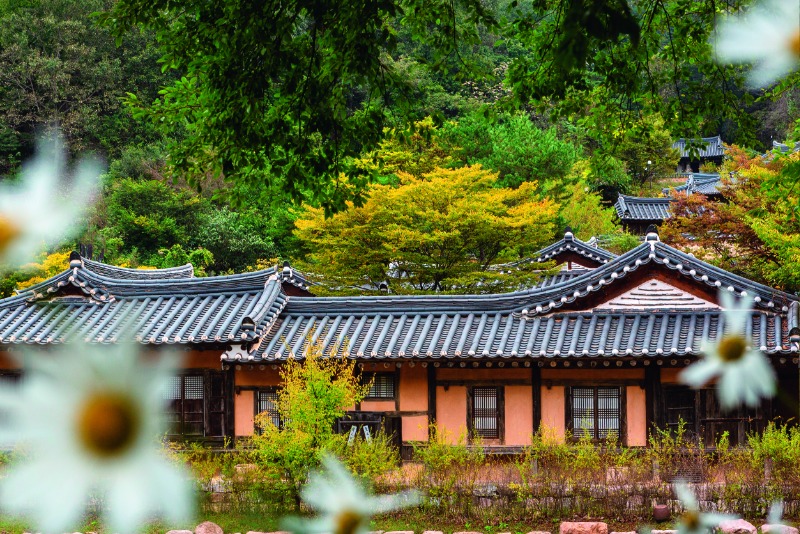
Gyenam Old House, presumably built in the 1800s, has a square layout with a central courtyard, typical of upper-class homes in the Andong region. The outer quarters (sarangchae) is located to the right of the gate, and the inner quarters (anchae) has a spacious wood-floored hall. Yi Gwi-yong, father of Yi Eon-sun, constructed this house as their clan’s head residence. It was relocated to the present site in 2008.
Heavy Comfort of Blankets
When the sun was about to set, I left the resort for dinner. As I had turned on the thermostat to prepare for the cold night, gentle warmth filled my room when I returned, thanks to the ondol floor heating system. With my hunger satisfied and a pleasant warmth rising below my feet, the tiredness of the day suddenly overwhelmed me. I lay down on the floor without even putting out the bedding. At home in Seoul, I rarely sit or lie down on the floor because I have a sofa in the living room and a bed in my bedroom. Usually, only a small part of my body, the soles of my feet, makes contact with my house. On the contrary, your whole body touches the floor in a hanok. Lying down on the floor, I observed the feeling in my buttocks, spine and the back of my head. Beneath the thin layer of flooring was a system of flues built of stone slabs and covered with earth to circulate hot air. I somehow felt as if the energy of nature emitted by the earth was rising from below.
I decided to take a shower before I grew too languid. Picking up my toiletries, I went to the bathroom, which was not unlike that of a nice hotel. I felt a bit disoriented, as if I had been transported from the past to modern times. The warm water gushing from the tap washed away my fatigue. Back in the room, I dried myself off and then spread out the bedding. When I booked the room, I had stated that I would be on my own, but the neat stack of bedding in the corner included two mattresses: thick and dense blankets called yo that are laid out every night and folded away during the day. Probably, the spare mattress was meant to be placed on top of the other in case the hard floor was uncomfortable. All the bedding was made in the traditional way, having a cotton cover stuffed with cotton wool. I liked the way the heavy, cotton-filled blanket with its crisp cover pleasantly pressed down on my body, as if it were hugging me tightly rather than me covering myself with it. Now, the memory of the interior of my grandparents’ house, which had been so vague, started to come back to me.
I had an idea why these memories had been so elusive. In my grandparents’ home, the rooms were almost always dim, the old wallpaper discolored and the flooring paper scorched brown by the heat coming from the stone slab flues. The traditional mulberry paper attached to the lattice doors was of poor quality, thick and rough. On the other hand, the rooms of the Gyenam Old House were brighter: the wallpaper was clean and the recessed lighting in the ceiling gave the impression that the house itself was emitting light. The door frames and other wooden structures supporting the walls and ceiling looked solid and intact, having never been exposed to the elements, and their soft, woody colors added a golden hue to the lighting. At the thought of the old house, I sat up, threw the blanket back and made my way to the doors to flick my fingers on the taut paper covering the lattices. A deep, clear sound like that of a drum rang out.
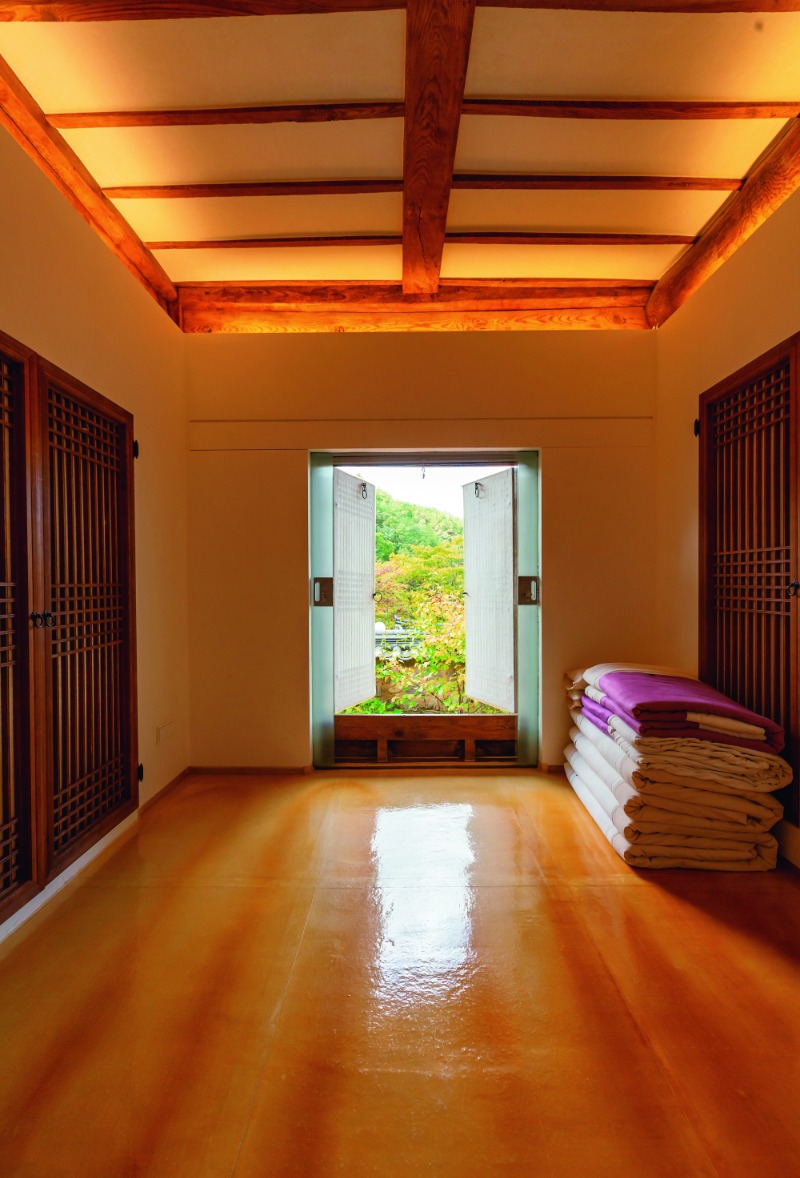
Gurume Resort consists of seven hanok built in the Andong area in the 17th to the 19th centuries. They were relocated to this precint of gentle hills to be used for accommodation. The bedding provided for guests are thick blankets stuffed with cotton wool and covered with cotton cloth. Crisp on the skin, cotton cloth was most widely used for bedding in the old days.
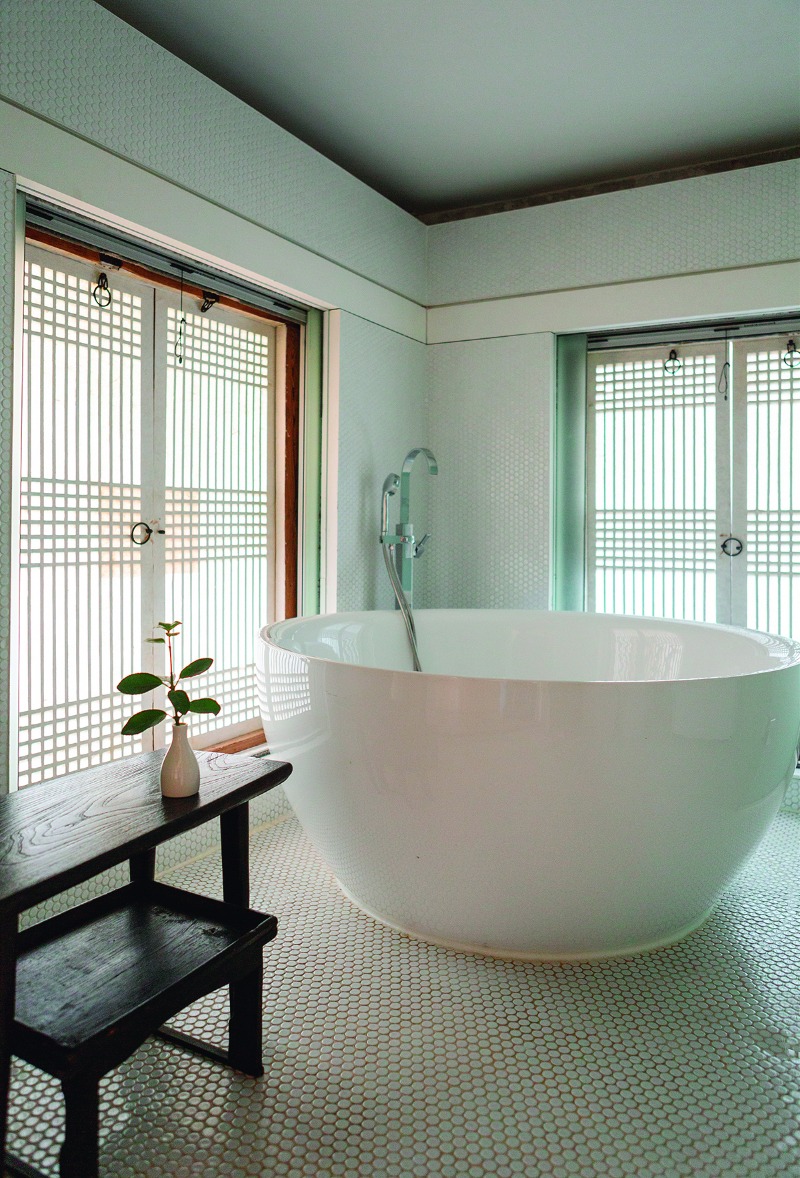
Contrary to rooms with the traditional ondol floor heating system, the bathroom was renovated in modern style for the convenience of guests. Like a regular hotel, the bathroom has a bathtub, shower and basic amenities.
At home in Seoul, I rarely sit or lie down on the floor because I have a sofa in the living room and a bed in my bedroom. Usually, only a small part of my body, the soles of my feet, makes contact with my house. On the contrary, your whole body touches the floor in a hanok.
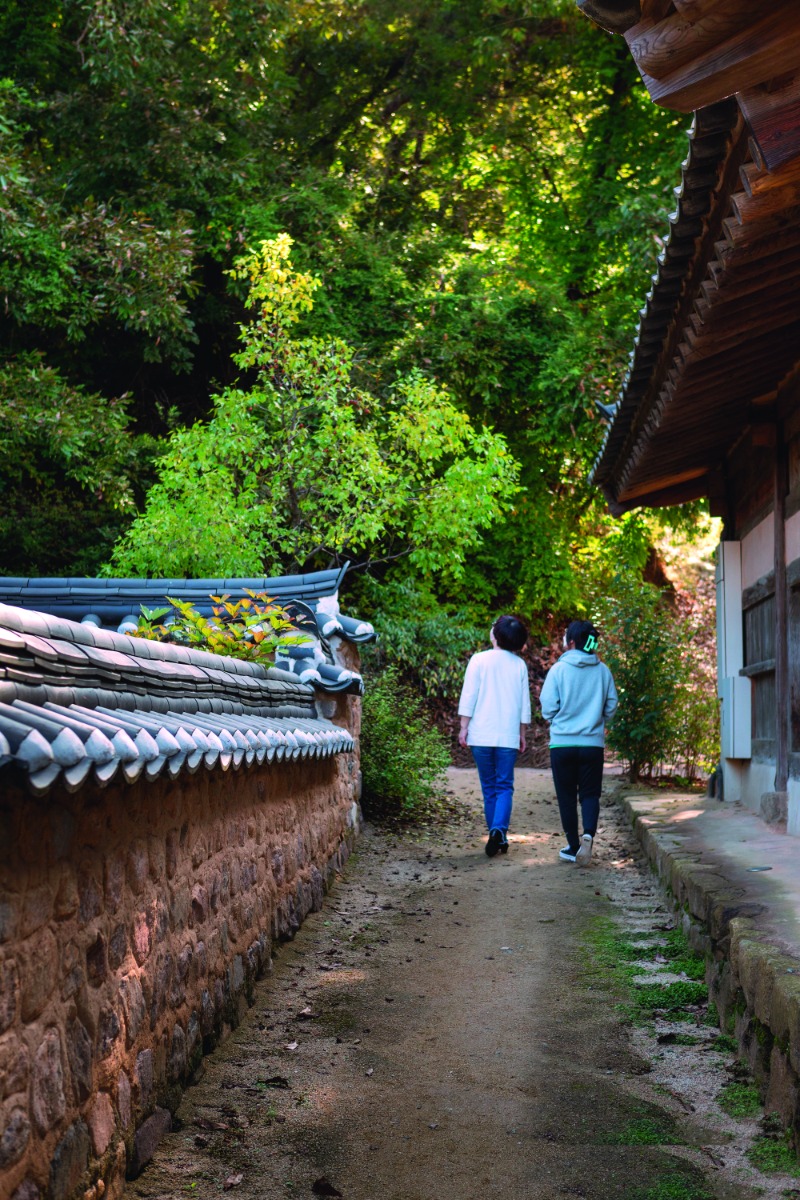
Narrow dirt paths meander between the old houses in the resort, perfect for strolling round to look at the houses, which vary in style and scale, and to enjoy the surrounding scenery.
The Warmth of Family
If there was something the two distinctly different houses had in common that made my elusive memories come flooding back to me, it was the cotton-filled blanket. The snug feel of the blanket reminded me of the warmth of my family. Even in those dark, shabby rooms, I had been happy. I loved the thick soybean paste stew and knife-cut noodle soup that Grandma made. After meals, Grandpa would smoke sitting against the wall with his wooden pillow at his back for support. Grandma would nag him for smoking while I was in the room, and he would rise quietly with his wooden pillow and go out to the hall. When bored, I would take out all the cassette tapes that my uncles had collected and play dominoes with them. I would also jumble up the tapes, putting them in the wrong cases just to play a prank on my uncles, but I’m not sure if they ever noticed. Now, with my grandparents having long since passed away and the occasion to talk to my uncles and aunt arising just once or twice a year, childhood memories feel like something from a former life.
From the inner quarters, other guests who appeared to be a family burst into laughter, the sound reaching me across the courtyard. I thought of something I wanted to write down, so I pulled the low table closer to me and typed a few sentences on my laptop. It seemed that the true value of a hanok could be better appreciated when it was occupied by a family rather than a lone traveler. I thought I had a lot to say, but found it hard to put anything into words, probably because I was excited and happy to be in a new place. Leaving the laptop on the desk, I went out to sit in the threshold of the hall. The autumn night air was chilly but refreshing to my warmed body. Looking up at the star-studded sky to read the constellations, I noticed there was something like a blade of grass hanging from the tip of the eaves. I stood up to look more closely and realized it was a praying mantis. Hanging upside down, the bug was motionless with its head raised toward the sky. How long had it been there like that? What was it thinking about? I imagined what might be in its mind until I found myself shivering with cold. Back inside, I got cozy under the blanket, thinking of the solitary praying mantis looking up at the sky, and before I knew it, I fell asleep.